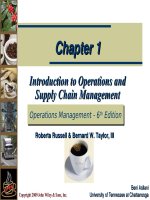Enterprise systems for management 2nd by motiwalla and thompson chapter 02
Bạn đang xem bản rút gọn của tài liệu. Xem và tải ngay bản đầy đủ của tài liệu tại đây (440.54 KB, 29 trang )
CHAPTER 2
SYSTEMS
INTEGRATION
1
Copyright © 2012 Pearson Education, Inc. Publishing as Prentice Hall
Learning Objectives
•
Understand the impact of organizational structure on
information systems.
•
Find out about the types of functional silos in organizations.
•
Learn about the evolution of information systems technology
generations and architectures and its influence on silo
environment.
•
Know what systems integration is and why it is important for
organizations.
•
Understand the role of Enterprise Resource Planning (ERP)
systems in systems integration.
2
Copyright © 2012 Pearson Education, Inc. Publishing as Prentice Hall
Preview
•
Systems integration means that you allow a heterogeneous
(hodgepodge) IS to communicate or integrate and share
information (or data) seamlessly with one another.
•
Systems integration is a key issue for an organization for its
growth - Management needs to pay close attention to this
issue.
•
ERP systems are a major kind of enterprise information
system allowing organizations to integrate different systems
into one organization-wide application with an integrated
database management system.
3
Copyright © 2012 Pearson Education, Inc. Publishing as Prentice Hall
Functional Silos
•
Silos are basically compartmentalized operating units isolated
from their environment.
Horizontal Silos
• The POSDCORB (Planning, Organizing, Staffing, Directing,
Coordinating, Reporting and Budgeting) categorization by
Luther Gulick led to a set of formal organization functions
such as control, management, supervision, and administration
starting in late 1930s.
•
Classification of organizations into departments like
Accounting and Human Resources, reflects the breaking of
complex tasks into smaller manageable tasks that could be
assigned to a group of people who could then be held
responsible.
4
Copyright © 2012 Pearson Education, Inc. Publishing as Prentice Hall
Figure 2-1 Functional Model of Organization
(POSDCORB)
5
Copyright © 2012 Pearson Education, Inc. Publishing as Prentice Hall
Functional Silos (Cont’d)
Vertical Silos
• Organizations also divided roles in hierarchical layers from
strategic planning to management control and operation control.
•
CEOs and Presidents plan long-term strategy, midlevel
management focuses on tactical issues and on the execution of
organizational policy whereas the lower-level management task
is to focus on the day-to-day operations of the company.
•
As organizations get big and complex they tend to break
functions into smaller units and assign staff the responsibility
for these activities allowing them to manage complexity as well
as specialize in activities that enhance productivity and
efficiency.
6
Copyright © 2012 Pearson Education, Inc. Publishing as Prentice Hall
Figure 2-2 Hierarchical Model of Organization
7
Copyright © 2012 Pearson Education, Inc. Publishing as Prentice Hall
Business Process and Silos
•
The problem of functional silos gave birth to business process
re-engineering (BPR).
•
The cross-functional business process can involve people and
resources from various functional departments working
together, sharing information at any level of the organization.
•
The cross-functional organizational structure breaks the
functional silos by opening up the informational flows from
one department to another.
8
Copyright © 2012 Pearson Education, Inc. Publishing as Prentice Hall
Figure 2-3 Matrix Structure of Organization
9
Copyright © 2012 Pearson Education, Inc. Publishing as Prentice Hall
Evolution of Information Systems in Organizations
•
The functions of an organization (e.g., sales, manufacturing,
and HR) are important as they provide a structure by which an
organization functions smoothly.
•
A silo information system is inefficient, inaccurate, and
expensive.
– The system creates bottlenecks for everyone and
information is not available in real-time.
•
The evolution of IS suggests that its role has generally been to
support evolving information needs of the organization.
10
Copyright © 2012 Pearson Education, Inc. Publishing as Prentice Hall
Figure 2-4 Functional Silos in Organization
11
Copyright © 2012 Pearson Education, Inc. Publishing as Prentice Hall
IS Architectures
•
Rapid advances in computer and networking technologies and
changing organizational dynamics, drive the emergence of
new information system models.
•
Web-based systems today use a distributed architecture
which allows the sharing of applications and data resources
between the client and the server computers.
•
In this configuration, personal computers are connected via a
network to a Web server that provides a window to an
application and database server, which could be a mainframe
or another type of computer.
12
Copyright © 2012 Pearson Education, Inc. Publishing as Prentice Hall
IS Functionalization
•
In addition to serving the different management levels, IS also
supports major business functions, such as manufacturing,
marketing, accounting, finance, and HR.
•
Each functional area has different information needs and
report requirements.
•
Each functional area in an organization also has multiple
levels of management, each requiring different levels of
analysis and details of information.
13
Copyright © 2012 Pearson Education, Inc. Publishing as Prentice Hall
Figure 2-5 Information Systems Architectures
14
Copyright © 2012 Pearson Education, Inc. Publishing as Prentice Hall
Figure 2-6 IS as Categorized by Functional and
Hierarchical Models
15
Copyright © 2012 Pearson Education, Inc. Publishing as Prentice Hall
Systems Integration
Logical
• Develop information systems that allow organizations to share
data with all of its stakeholders based on need and
authorization.
• Management needs to change organizational structures,
processes, and employee roles and responsibilities.
Physical
• Provide seamless connectivity between heterogeneous
systems.
• Business process reengineering involves changing the mindset
of the employees in the organization, encouraging and enabling
them to do their tasks in a new way.
16
Copyright © 2012 Pearson Education, Inc. Publishing as Prentice Hall
Steps in Integrating Systems
Step 1
Resource
categorization
Instituting IT support for an integrated systems
environment is necessary to avoid support and
maintenance problems with the integrated
system.
Step 2
Compliance and
standards
Develop a single sign-on policy because all
employees and external partners will need
access to an integrated system from anywhere,
anytime.
Step 3
Legacy systems
support
Develop a policy in support of older legacy
applications.
Step 4
Middleware tools
Middleware tools are essential for integration in
the short term if existing applications must be
used by the organization.
17
Copyright © 2012 Pearson Education, Inc. Publishing as Prentice Hall
Steps in Integrating Systems (Cont’d)
Step 5
Authentication
and authorization
policies
Single sign-on policy for application and data
access because all employees and external
partners will need access to an integrated
system from anywhere, anytime.
Step 6
Centralized IT
services and
support
The IT staff needs to be able to support all
applications and platforms with a centralized IT
help desk support.
Step 7
Back-up,
recovery, and
security
A good back-up and recovery system is
essential if there is a system failure or a major
disaster.
Step 8
Hardware and
software
standardization
Develop organization standards and policy on
acquisition of new hardware and software which
is aligned with organization IT strategy.
18
Copyright © 2012 Pearson Education, Inc. Publishing as Prentice Hall
Benefits and Limitations of Systems Integration
Benefits
Limitations
Increased Revenue and Growth
High Initial Set-up Costs
Leveling the Competitive Environment
Power and Interdepartmental Conflicts
(due to the sharing of information)
Enhanced Information Visibility
Long-term and Intangible ROI
(Usually several years)
Increased Standardization
Creativity Limitations (Restricts
Creativity and Independence)
19
Copyright © 2012 Pearson Education, Inc. Publishing as Prentice Hall
ERP and Systems Integration
•
Enterprise Resource Planning (ERP) systems are integrated,
multi-module application software packages designed to serve
and support several business functions across an
organization.
•
ERP systems are typically commercial software packages that
facilitate collection and integration of information related to
various areas of an organization.
•
ERP systems enable the organization to standardize and
improve its business processes to implement best practices
for its industry.
20
Copyright © 2012 Pearson Education, Inc. Publishing as Prentice Hall
ERP’s Role in Logical Integration
•
ERP systems require organizations to focus on business
process rather than on functions.
•
ERP systems come with built-in processes for a wide variety
of common business functions.
•
An ERP system implements best practices via specific built-in
steps for processing a customer order in terms of:
– order entry.
– routing through departments.
– communication of output to various parties.
21
Copyright © 2012 Pearson Education, Inc. Publishing as Prentice Hall
ERP’s Role in Physical Integration
•
Before installing the ERP system, an organization may have to
upgrade or install middleware or get rid of their legacy
system’s hardware and software.
•
Integration is also required at the Data level, Client level, and
at the Application level.
•
A good ERP implementation improves operational efficiency
with better business processes that focuses on organizational
goals rather than on individual departmental goals.
•
Improved efficiency with a paperless flow and electronic data
interchange (EDI) or business-to-business (B2B) commerce
environment with partners.
22
Copyright © 2012 Pearson Education, Inc. Publishing as Prentice Hall
Implications for Management
• Silos do not work.
– Most organizations lose out in the long-term when
information is not shared in real time across the functional
boundaries within the company.
• System integration has many hidden benefits.
– Allows decision making to be cascaded to all departments
– Allows employees at lower-levels to make better decisions
while interacting with clients or partners.
• System integration has many challenges.
– Replacing old hardware and software
– Working with IT consultants
– Human challenges, such as impact on IT staff, department
heads losing control of data, and rumors of layoffs
23
Copyright © 2012 Pearson Education, Inc. Publishing as Prentice Hall
Implications for Management (Cont’d)
•
Systems integration raises many new ethical issues.
– Possibility of some employees exploiting information
for personal advantage and illegal access of
information.
•
Remedies can consist of:
– Develop policies on ethical usage of information.
– Install proper security software and hardware (like
firewalls).
– Allocate resources for training and education on
accessing information.
24
Copyright © 2012 Pearson Education, Inc. Publishing as Prentice Hall
Summary
•
Functional silos categorize an organization’s tasks and
activities into groups to improve efficiency and responsibility
of work in the organization.
•
Silos can improve productivity, but they often lead employees
to achieve departmental goals rather than overall
organizational goals.
•
IS over the years have been divided horizontally by functions
and vertically by hierarchical levels.
•
IS architecture has evolved from centralized mainframe
architecture to personal computers with distributed or client–
server architecture.
25
Copyright © 2012 Pearson Education, Inc. Publishing as Prentice Hall









